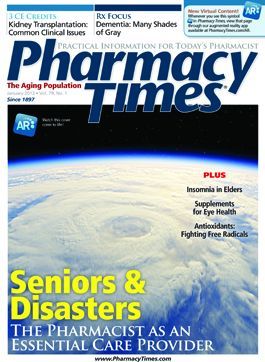New FDA Actions: Amarin's Vascepa
Vascepa (icosapent ethyl) is approved as an adjunct to diet and exercise to reduce triglycerides in adults with severe hypertriglyceridemia.
Vascepa (icosapent ethyl) is approved as an adjunct to diet and exercise to reduce triglycerides in adults with severe hypertriglyceridemia.
The FDA approved Amarin’s Vascepa (icosapent ethyl) capsules as an adjunct to diet to reduce triglyceride (TG) levels in adult patients with severe hypertriglyceridemia. Hypertriglyceridemia is considered severe at levels of 500 mg/dL and above.
The approval carries the limitations that the effect of Vascepa on the risk of pancreatitis has not been determined in patients with severe hypertriglyceridemia, nor has its effect on cardiovascular mortality and morbidity been determined.1 Approximately 4 million Americans have severe hypertriglyceridemia.2
Pharmacology and Pharmacokinetics
Vascepa is an ethyl ester of eicosapentaenoic acid (EPA). It is suggested that EPA exerts its effect by reducing hepatic very low-density lipoprotein triglycerides (VLDL-TG) synthesis and/or secretion and by enhancing TG clearance from circulating VLDL particles. Potential mechanisms of action include an increase in beta-oxidation, an inhibition of acyl-CoA:1,2-diacylglycerol acyltransferase, a decrease in lipogenesis in the liver, and an increase in plasma lipoprotein lipase activity.
Gender did not affect the pharmacokinetics of Vascepa. EPA reached its peak plasma concentrations approximately 5 hours after the oral dose was ingested. In clinical trials, Vascepa was given with food or following a meal. It is metabolized primarily by the liver via beta-oxidation, similar to dietary fatty acids. Vascepa does not undergo renal excretion. Vascepa has not been studied in patients with renal or hepatic impairment.1
Dosage and Administration
Before initiating treatment with Vascepa, lipid levels should be assessed and other causes for hypertriglyceridemia, such as diabetes mellitus, hypothyroidism, alcohol consumption, or medications, should be managed. A lipid-lowering diet and exercise regimen should be initiated prior to and throughout treatment with Vascepa.
Vascepa should be dosed as 2 g twice daily with food, for a total daily dose of 4 g. The capsules should be swallowed whole and never opened, crushed, dissolved, or chewed.
Vascepa is available as a 1-g capsule.1
Clinical Trials
Vascepa was evaluated in a randomized, placebo-controlled, double-blind, parallel-group study of adult patients with severe hypertriglyceridemia. Baseline TG levels were between 500 and 2000 mg/dl with a median baseline of 684 mg/ dL. The median baseline low-density lipoprotein cholesterol (LDL-C) was 86 mg/dL and the median baseline high-density lipoprotein cholesterol (HDL-C) was 27 mg/dL. Of the study population, 88% was Caucasian and 76% was male. The mean age was 53 years and the mean body mass index was 31 kg/ m2 . At baseline, 35% of patients were on concomitant statin therapy, 28% had diabetes, and 39% had TG levels greater than 750 mg/dl. Seventy-six patients were randomized to receive Vascepa 4 g daily and 75 were randomized to receive placebo.
At the end of the 12-week study, the Vascepa arm demonstrated a statistically significant reduction in TG of 33% without an increase in LDL-C relative to placebo. The Vascepa arm also showed statistically significant placebo-adjusted median reductions from baseline in non-HDL-C (18%), total cholesterol (16%), VLDL-C (29%), and apolipoprotein B (9%).1,2
Contraindications, Warnings, and Precautions
Vascepa is contraindicated in patients with a known hypersensitivity to any of its components. Patients with known hepatic impairment should have alanine aminotransferase and aspartate aminotransferase levels monitored periodically during treatment with Vascepa.
The EPA of Vascepa is obtained from fish oil. It is unknown whether patients with fish and/or shellfish allergies are at an increased risk of allergic reaction to Vascepa; however, it should be used cautiously in this population.
Omega-3 acids, such as EPA, may prolong bleeding time. Patients using Vascepa concomitantly with other drugs known to affect coagulation (such as antiplatelet agents) should be monitored periodically.
Vascepa is Pregnancy Category C and should only be used during pregnancy if the potential benefit outweighs the risk to the fetus. Studies with omega-3-acid ethyl esters have shown them to be excreted in human breast milk; however, the effect of this excretion is unknown. Caution is recommended when Vascepa is used in patients who are breast-feeding. Vascepa is not approved for use in pediatric patients.
Dr. Holmberg earned her PharmD from the University of Connecticut and completed an ambulatory care residency at the Phoenix VA Healthcare System. Her practice has also included pediatrics and inpatient mental health. She resides in Phoenix, AZ.
References
- Vascepa complete prescribing information. Vascepa website. www.vascepa.com/full-prescribing-information.pdf. Accessed November 10, 2012.
- Amarin announces FDA approval of Vascepa (icosapent ethyl) capsules for the reduction of triglyceride levels in adult patients with severe hypertriglyceridemia. http://investor.amarincorp.com/releasedetail.cfm?ReleaseID=696027. Accessed November 10, 2012.

